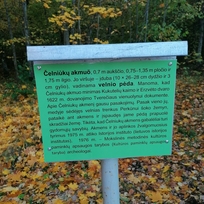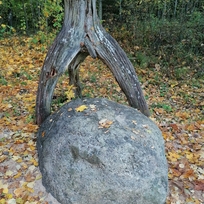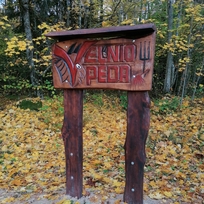Im Ažubalis-Wald befindet sich ein Čelniukai-Stein mit einer Vertiefung namens „Teufelsfuß“.
Der Stein mit dem Fuß ist aus bläulich-grauem, feinkörnigem, unregelmäßig geformtem Granit, 1,75 m lang, 0,75–1,35 m breit und bis zu 70 cm hoch. In der Mitte des oberen Bereichs befindet sich eine 10 × 26–28 cm große und bis zu 3,2 cm tiefe Vertiefung, die als „Teufelsfuß“ bezeichnet wird. Der Stein steht unter Denkmalschutz.
Man erzählt sich, der Teufel habe in einer Fichte neben einem Stein gesessen, und als ein lauter Donnerschlag ertönte, sei er auf den Stein gesprungen und habe mit dem Fuß aufgestampft. Man sagt, wenn man ein Kreuz in den „Teufelsfuß“ stecke, würde dieser schrumpfen – oder besser gesagt: wachsen.
Man erzählt sich, dass unter dem Stein ein goldener Pflug und eine silberne Egge verborgen seien, oder dass Napoleons Soldaten, aus Furcht, die Russen würden ihre Regimentsfahne nicht annehmen, diese unter dem Stein vergruben und ein Zeichen in Form eines Infanteriefußes einmeißelten. Darüber hinaus werden verschiedene Legenden um den Stein erzählt und aufgeführt. – „Kein Mensch wird dort vorbeikommen, ohne einen Fehler zu machen.“
Man nimmt an, dass der Čelniukai-Stein 1622 erstmals erwähnt wurde, als Petras Pocis das Dorf Kukutėliai und das Gut Erzvėtas dem Kloster Tverečius schenkte. Nicht nur der Stein selbst, sondern auch die umliegende Gegend ist unter dem Namen „Teufelsfuß“ bekannt. Legenden zufolge wird der Čelniukai-Stein mit dem Stein mit Füßen in Verbindung gebracht, der sich einst in Triluščiai befand.
Im Jahr 2021 wurde der Čelniukai-Stein in das Gebiet der Ältestenschaft Mielagėnai verlegt. Bei der Neuordnung der Verwaltungsgrenzen der Ältestenschaften kam es vor, dass der Stein, der sich im Sommer noch in der Ältestenschaft Tverečius befunden und keinen Zentimeter von seinem Platz bewegt hatte, nun in der Ältestenschaft Mielagėnai landete. Die Ältestenschaft Mielagėnai begutachtete nicht nur das neu „entdeckte“ Kulturdenkmal, sondern begann im Herbst auch mit Arbeiten im Wald von Ažubalis: Sie säuberten die Umgebung des mythischen Čelniukai-Steins.
Mindaugas Milinavičius, ein Volkskünstler, der in der Mielagėnai-Ältestenschaft Kikižerys lebt und arbeitet, erklärte sich gerne bereit, diese historische Stätte zu verschönern. Er schnitzte ein stilisiertes Schild und schenkte es der Ältestenschaft.
Information aktualisiert am 2025-12-12






Bewertungen